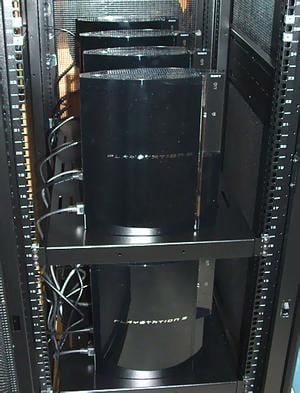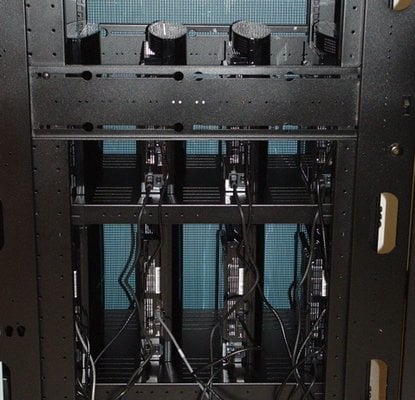
Stacked Sonies: the 'gravity grid' set up
Posted on 03/05/2008 11:40:02 AM PST by ShadowAce
When most of us arrived home with our newly purchased PS3, we couldn't wait to start annihilating aliens in Resistance: Fall of Man or kicking butt kung fu-style in Virtua Fighter 5. Not astrophysicist Gaurav Khanna - he used his to build a supercomputer.
Khanna now owns a total of 16 PS3 consoles, all linked together to provide the same computing power as a 400-node supercomputer. His set up, which he calls a 'gravity grid', is used to simulate the activity of very large black holes for the Physics Department at the University of Massachusetts.

Stacked Sonies: the 'gravity grid' set up
The project is an attempt to estimate the properties of gravity waves generated by the collision of two black holes. Gravitational waves are 'ripples' in space-time that travel at the speed of light. These were theoretically predicted by Einstein's general relativity, but have never been directly observed.
In order to run his simulation data on the consoles, Khanna had to load the PS3s with Linux. What makes the gaming console more effective than high-end computers for complex research algorithms is the Cell chip built by IBM to process high-end gaming functions.

Linux powered
"Linux can turn any system into a general-purpose computer, but for it to work for me I have to run my own code on it for astrophysics applications. The hard part of the job was to make sure my own calculations could run fast on the platform, which meant I had to optimise the written code so it could utilise the new features of the system."
The 16 PS3s haven't been physically modified. They're networked together using an inexpensive Gigabit Ethernet switch.
"Overall, a single PS3 performs better than the highest-end desktops available and compares to as many as 25 nodes of an IBM Blue Gene supercomputer," Khanna noted.
More details from Khanna's project site here.
I honestly have no idea how the law/legalities work in a situation like this.
That's not an optimal solution for cross CPU communication. I imagine the application must run something akin to SETI@Home where discreet units of calculations are distributed across the available CPUs with the results being returned over the network. Presumably 16 PS3s isn't the maximum number that could be used for the project.
Depends on your price point, I suppose. He could have used IB and a $50,000 - $80,000 IB switch.
bkmark. thanks.
lol, that might be a tad ‘spendy’ for these lads.
It would be great as a secondary processor in place of the SIMD units (SSE, 3DNow) that's in modern chips, but it's not multi-purpose enough to be used as the main processor of a computer. Folding@Home only assigns PS3s those types of units it can handle.
Folding@Home has 32,577 PS3s doing work, many from the Free Republic team that currently ranks #50 out of 3,000 teams.
Somehow I don’t think the question is if they’re banned from export to those countries, but rather if the countries in question allow them to be imported... could you imagine a ‘good’ Muslim’s reaction to female video game characters?
Honestly, I wouldn’t really worry - if whoever wanted to simulate a nuclear explosion, sure they could wire a bunch of PS3’s together, but they could just buy computer parts off the internet and assemble them by hand, or wire a bunch of ‘normal’ computers together, the only real difference being the cost, and something tells me that if you have the money to build nuclear weapons, you have the money not to need to be cheap about how you get your computing power.
Disclaimer: Opinions posted on Free Republic are those of the individual posters and do not necessarily represent the opinion of Free Republic or its management. All materials posted herein are protected by copyright law and the exemption for fair use of copyrighted works.